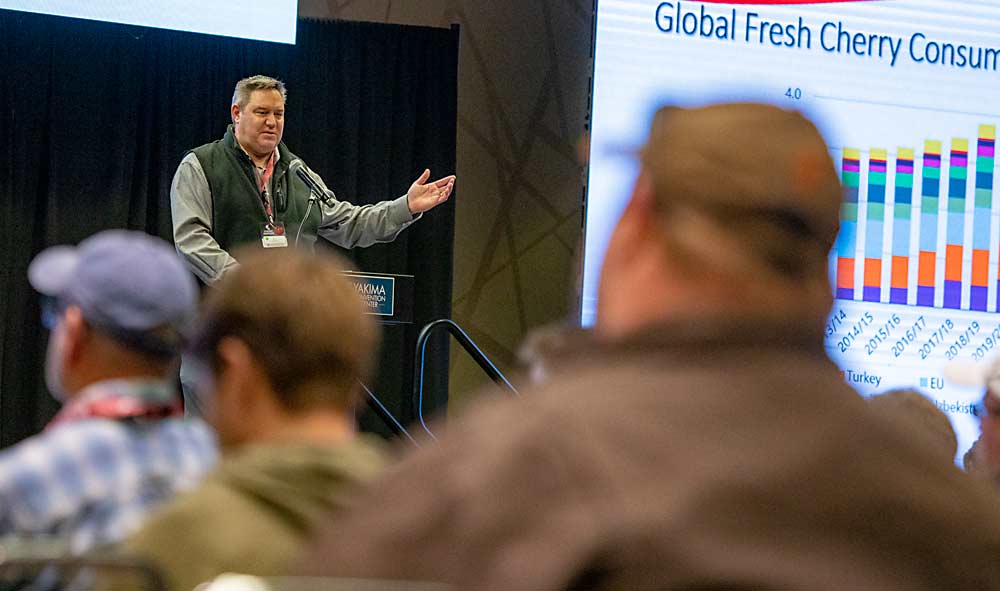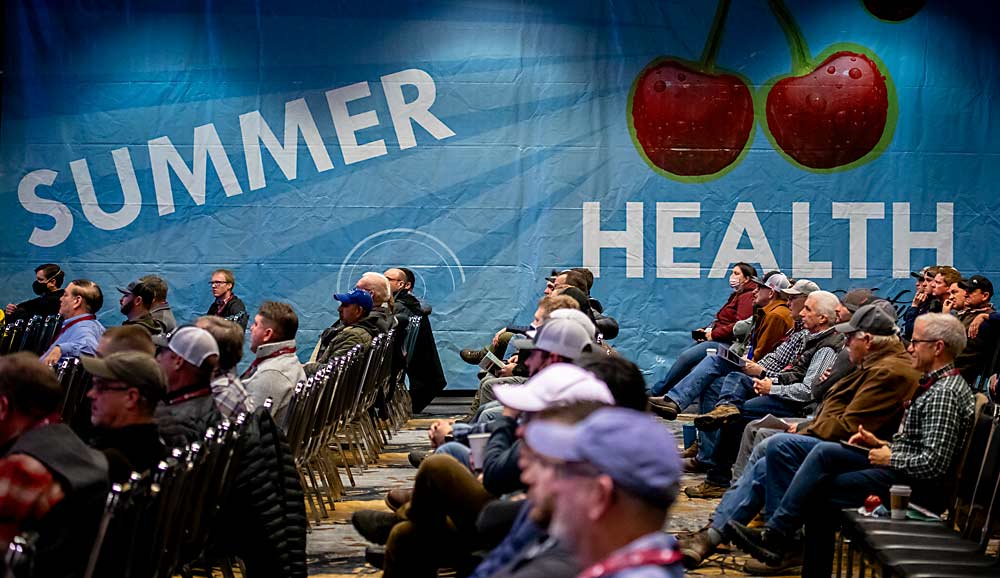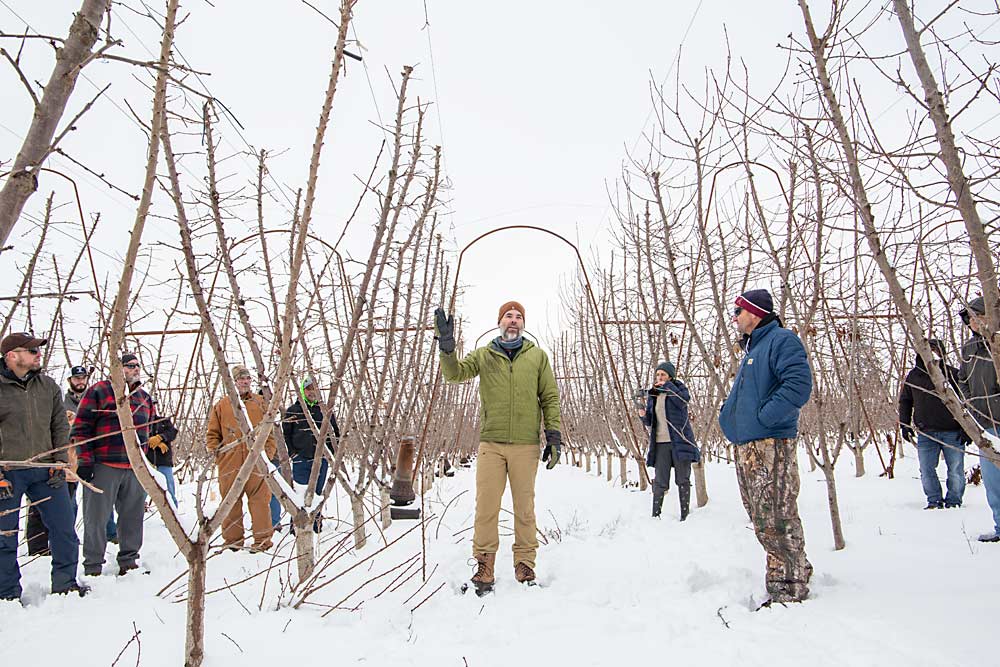
The 2021 cherry season was shaping up to be a tough year even before the record-breaking heat wave hit, according to B.J. Thurlby, president of Northwest Cherry Growers.
“Our challenges last year started with California,” Thurlby told growers gathered at the Cherry Institute at the Yakima Convention Center on Jan. 7. “They had a really nice crop, over 9 million boxes,” he said, compared to an average of 5 million.
That large crop also overlapped in the marketplace with the Northwest cherry season for 29 days, accounting for 3.4 million boxes, he said. Usually, there’s about a million boxes, or less, in direct competition with Northwest growers.
Northwest growers finished the season shipping just over 20 million boxes, Thurlby said, after loses of 4 or 5 million boxes to heat, by his estimate. Looking at the size distribution, growers harvested plenty of 10 and 10.5 row cherries, but the heat prevented fruit from reaching larger sizes.
Domestically, cherries sold for average prices from $3.49 to $3.99 per pound, Thurlby said. That’s well above the promotional prices consumers have come to expect in July — no cherries on sale for $0.99 or even $1.99 per pound — and which may have motivated more purchases.
“The reality is we know we need these higher ad prices so you guys can get paid,” Thurlby said. “Everything’s gone up and consumers can take a while to adjust to that, but one of the challenges we have is that cherry is an impulse item.”
One thing that’s working to attract new consumers and more repeat purchases is Northwest Cherry Growers’ health messaging. In talks about the domestic and export marketing programs, given by James Michael and Keith Hu, respectively, they shared examples of traditional and digital advertising that shows how the health-conscious approach is resonating.

In the export market, fruit quality suffered with the heat, Hu said. And the trade war tariffs continue to make it difficult to sell fruit in China, but other markets in Asia offer opportunity to diversify.
“I see the foreign markets like how I manage my own stock portfolio,” Hu said. “Diversification is key to making sure the portfolio continues to grow.”
Thurlby also acknowledged the challenges in the export arena, but he said he takes comfort in charts showing that global cherry consumption is growing steadily.
“The good news is we’ve got a great product and the demand is going to be there,” he said.
Learning from last year’s heat
Lessons from the heat wave was the focus of the next talk, led by Washington State University physiologist Matt Whiting.
Whiting told growers when it was hot, how long it was hot and the orchard’s experience with heat all make a difference in how trees respond to heat stress. For example, trees that suffer three or six hours can recover well, he said. After 12 or 24 hours, they don’t recover all the way. Also, cherries exposed to heat early in the season develop resilience to extreme heat later in the season.
Grower Jake Gutzwiler compared a season of heat stress to a summer with rain problems. It can lead to a rush to pick immature fruit, which happened in 2021. Some customers threatened to quit buying if they received any more immature fruit.
Victor Bueno of Washington Fruit and Produce shared a host of tips for harvesting at night, which many producers did to beat the summer heat. They include: making sure extra batteries are available for headlamps, booking light towers early, giving checkers extra light as they inspect bins and making sure plenty of trucks are available to haul fruit to warehouses.
“It’s a completely different world when we were working at night,” Bueno said.
No Cherry King
In a departure from tradition, due to weather and Covid complications, no cherry king was crowned this year.
During the morning session on Friday, the industry re-elected Robert Kershaw and Pat Sullivan to serve on the Washington State Fruit Commission and re-elected Julie Bosma, Greg Knight, Doug Gibson and Jeff Baldwin to serve on the Washington Cherry Marketing Committee.
Systems tour
Growers filed into the Yakima Convention Center for the annual Cherry Institute Friday morning, but the action started the day before, on Jan. 6, with Washington State University’s cherry systems tour.
Researcher Matt Whiting typically precedes the institute with visits to Yakima Valley cherry orchards to discuss the pros and cons of different training and pruning systems. Roughly 60 people braved chilly weather and snowy orchard floors Thursday to check out three orchards.

Keith Oliver of Olsen Bros. showed off a 2021 planting of Santina and Black Pearl cherries in UFO training on Gisela 6 and Gisela 12 rootstocks, respectively, in Benton City. The company planted in a straight row but trained the trees into a V-trellis, alternating each trunk to either side to give each leader more room to grow. Oliver expects to prune so that upright fruiting branches are 8–10 inches apart.
Also in Benton City, Shawn Gay of Finley showed off his 2018 Y-trellised trees, trained with four leaders, two on each side. He has Coral Champagne on G.6 and Chelan on Mazzard. He started with a formal Tatura system, training lateral branches straight sideways, but he has since softened and allowed the laterals to bend upward to fill space, a change that has cut down on labor.
In nearby Grandview, managers from Allan Bros. discussed a 2018 V-trellis block of Skeena cherries, each with two leaders, on Mazzard rootstocks. Travis Allan said the system fills space and produces well but will require diligent renewal pruning and training.
“A lot of renewal in here, and keep them young,” Allan said.
—by Kate Prengaman and Ross Courtney






Leave A Comment